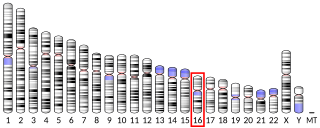
Whirlin is a protein that in humans is encoded by the DFNB31 gene.

Elongation factor Tu, mitochondrial is a protein that in humans is encoded by the TUFM gene. It is an EF-Tu homolog.

Spermine synthase is an enzyme that in humans is encoded by the SMS gene. The protein encoded by this gene belongs to the spermidine/spermine synthases family. This gene encodes a ubiquitous enzyme of polyamine metabolism.

Protein Jumonji is a protein that in humans is encoded by the JARID2 gene. JARID2 is a member of the alpha-ketoglutarate-dependent hydroxylase superfamily.

DEAD (Asp-Glu-Ala-Asp) box polypeptide 27, also known as DDX27, is a human gene.

ATPase inhibitor, mitochondrial is an enzyme that in humans is encoded by the ATPIF1 gene.

Putative Polycomb group protein ASXL1 is a protein that in humans is encoded by the ASXL1 gene.

Sodium/hydrogen exchanger 8 is a protein that in humans is encoded by the SLC9A8 gene.

N-terminal EF-hand calcium-binding protein 2 is a protein that in humans is encoded by the NECAB2 gene.

1-acyl-sn-glycerol-3-phosphate acyltransferase gamma is an enzyme that in humans is encoded by the AGPAT3 gene. The protein encoded by this gene is an acyltransferase that converts lysophosphatidic acid into phosphatidic acid, which is the second step in the de novo phospholipid biosynthetic pathway. The encoded protein may be an integral membrane protein. Two transcript variants encoding the same protein have been found for this gene.

Elongation factor Ts, mitochondrial is a protein that in humans is encoded by the TSFM gene. It is an EF-Ts homolog.

SET and MYND domain-containing protein 4 is a protein that in humans is encoded by the SMYD4 gene.

Deoxyribonuclease-1-like 2 is an enzyme that in humans is encoded by the DNASE1L2 gene.

Ninein-like protein is a protein that in humans is encoded by the NINL gene. It is part of the centrosome.

Rho guanine nucleotide exchange factor 4 is a protein that in humans is encoded by the ARHGEF4 gene.

Meckel syndrome, type 1 also known as MKS1 is a protein that in humans is encoded by the MKS1 gene.

SLX4 is a protein involved in DNA repair, where it has important roles in the final steps of homologous recombination. Mutations in the gene are associated with the disease Fanconi anemia.

Ubiquinone biosynthesis protein COQ9, mitochondrial, also known as coenzyme Q9 homolog (COQ9), is a protein that in humans is encoded by the COQ9 gene.

caprin family member 2, also known as CAPRIN2, is a human gene.

Mitochondrial translational release factor 1-like is a protein that in humans is encoded by the MTRF1L gene.
















